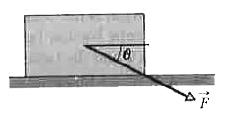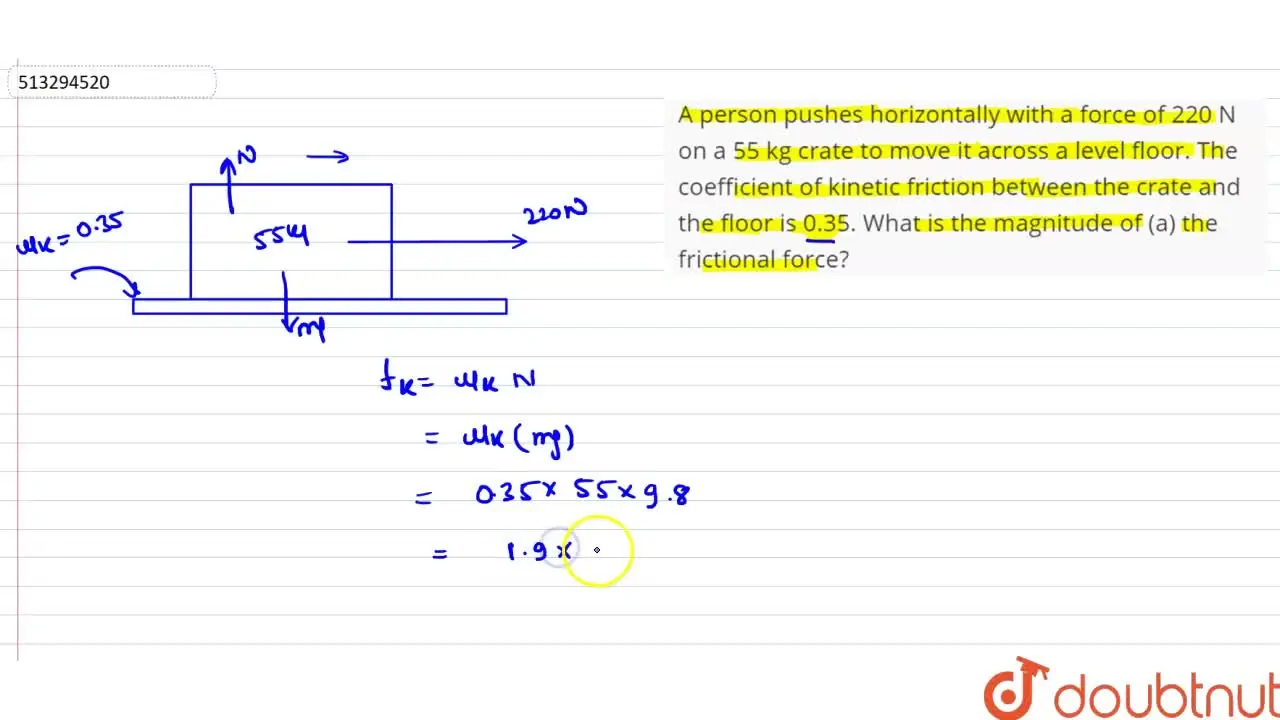A person pushes horizontally with a force of 220 N on a 55 kg crate to move it across a level floor. The coefficient of kinetic friction between the crate and the floor is 0.35. What is the magnitude of (a) the frictional force?
A force is being applied to accelerate a crate in the presence of friction. We apply Newton.s second law to solve for the acceleration.
 Figure 6-16 The free-body diagram for the crate discussed in Sample Problem 6.07.
Figure 6-16 The free-body diagram for the crate discussed in Sample Problem 6.07.
Express: The free-body diagram for the crate is shown I Fig. 6-16. We denote as the horizontal force of the person exerted on the crate (in the +x direction), is the force of kinetic friction in the -x direction), is the vertical normal force exerted by the floor (in the +y direction), and is the force of gravity. The magnitude
of the force of friction is given by Eq. 6-2: , Applying Newton.s second law to the x and y axes, we obtain
respectively.
Calculation: The second equation here yields the normal force , so that the friction is
What is the magnitude of (a) the acceleration of the crate?
Calculation: The first equation here becomes
which (with F= 220 N) we solve to find
Learn: For the crate to accelerate, the condition must be met. As can be seen from the equation above, the greater the value of , the smaller the acceleration under the same applied force.
Related Playlists
- BOOK - RESNICK AND HALLIDAYCHAPTER - FORCE AND MOTION-IIEXERCISE - CHECKPOINTS5videos
FORCE AND MOTION-II
- BOOK - RESNICK AND HALLIDAYCHAPTER - FORCE AND MOTION-IIEXERCISE - PROBLEMS33videos
FORCE AND MOTION-II
- BOOK - RESNICK AND HALLIDAYCHAPTER - FORCE AND MOTION - I EXERCISE - PRACTICE QUESTIONS (Integer Type)3videos
FORCE AND MOTION - I
- BOOK - RESNICK AND HALLIDAYCHAPTER - GAUSS' LAW EXERCISE - PRACTICE QUESTIONS (INTEGER TYPE)3videos
GAUSS' LAW
Similar Questions
A 3.5 kg block is pushed along a horizontal floor by a force →F of magnitude 15 N at an angle θ=40∘ with the horizontal (Fig. 6-33). The coefficient of kinetic friction between the block and the floor is 0.25. Calculate the magnitudes of (a) the frictional force on the block from the floor and (b) the block's acceleration.
 View Solution
View SolutionA forward horizontal force of 12 N is used to pull a 240 N crate at constant velocity across a horizontal floor. The coefficient of friction is
View SolutionYou want to apply a force on a box so that it moves with constant speed across a horizontal floor. The coefficient if kinetic friction between the box and the floor is μk. Of the flur following cases, the force you apply on the box will be smallest when you
View SolutionA force of F = 12.0 N is applied to a 8.00 kg block at a downward angle of 30∘ as shown in the figure.

The coefficient of static friction between the block and the floor is 0.700 and the coefficient of kinetic friction is 0.400. What is the magnitude of the frictional force on the block?View SolutionA crate of mass m is pulled with a force F along a fixed right angles horizontal trough as in figure. The coefficient of kinetic friction between the crate and the trough is μ. Find the value of force F required to pull it along the trough with constant velocity.
 View Solution
View SolutionA block of mass 0.1 is held against a wall applying a horizontal force of 5N on block. If the coefficient of friction between the block and the wall is 0.5, the magnitude of the frictional force acting on the block is:
View SolutionA factory worker pushes a 25.0 kg crate downward at an angle of 30∘ below the horizontal a distance of 6.0 m along a level floor.
(a) What magnitude of force must the worker apply to move the crate at constant velocity, if the coefficient of kinetic friction between the crate and floor is 0.3 ?
(b) How much work is done on the crate by this force when the crate is pushed a distance of 6.0 m?
(c) How much work is done on the crate by friction during this displacement ?
(d) How much work is done by the normal force and by gracity ?
(e) What is the total work done on the crate ? Take g=10m/s2View SolutionA block of mass 0.1 kg is held against a wall by applying a horizontal force of 5 N on the block. If the coefficient of friction between the block and the wall is 0.5, then the magnitude of the frictional force acting on the block is
View SolutionFigure 6-47 shows three crates being pushed over a concrete floor by a horizontal force F of magnitude 425 N. The masses of the crates are m1=30.0kg,m2=10.0kg,andm3=20.0kg The coefficient of kinetic friction between the floor and each of the crates is 0.700. (a) What is the magnitude F32 of the force on crate 3 from crate 2? (b) If the crates then slide onto a polished floor, where the coefficient of kinetic friction is less than 0.700, is magnitude F32 more than, less than, or the same as it was when the coefficient was 0.700?
 View Solution
View SolutionA block of mass m slips on a rough horizontal table under the action of horiozontal force applied to it. The coefficient of friction between the block and the table is μ. The table does not move on the floor. Find the total frictional force aplied by the floor on the legs of the table. Do you need the friction coefficient between the table and the floor or the mass of the table ?
 View Solution
View Solution


